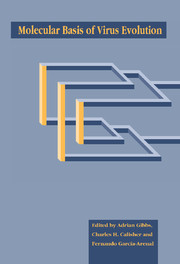Book contents
- Frontmatter
- Contents
- List of contributors
- Editors' preface
- Conference participants
- 1 Introduction and guide
- Part I The impact of viral diseases
- Part II Origins of viruses and their genes
- Part III Sources of virus variation
- Part IV Molecular interactions of viruses and their hosts
- Part V Viruses, hosts and populations
- Part VI Case studies of viral taxa; their systematics and evolution
- 18 Evolution of poxviruses and African swine fever virus
- 19 Molecular systematics of the flaviviruses and their relatives
- 20 Herpesviridae
- 21 Aphthovirus evolution
- 22 Evolution of the Bunyaviridae
- 23 Evolution of the tobamoviruses
- 24 The luteovirus supergroup: rampant recombination and persistent partnerships
- 25 The evolution of the Reoviridae
- 26 Genetic variation and evolution of satellite viruses and satellite RNAs
- 27 Molecular evolution of the retroid family
- 28 Adaptation of members of the Orthomyxoviridae family to transmission by ticks Patricia
- 29 The Order Mononegavirales: evolutionary relationships and mechanisms of variation
- 30 The molecular evolution of the human immunodeficiency viruses
- 31 Molecular evolution of papillomaviruses
- 32 Molecular systematics of the Potyviridae, the largest plant virus family
- 33 Evolution of alphaviruses
- 34 Evolution of influenza viruses: rapid evolution and stasis
- Part VII Techniques for viral systematics
- Index
25 - The evolution of the Reoviridae
Published online by Cambridge University Press: 04 May 2010
- Frontmatter
- Contents
- List of contributors
- Editors' preface
- Conference participants
- 1 Introduction and guide
- Part I The impact of viral diseases
- Part II Origins of viruses and their genes
- Part III Sources of virus variation
- Part IV Molecular interactions of viruses and their hosts
- Part V Viruses, hosts and populations
- Part VI Case studies of viral taxa; their systematics and evolution
- 18 Evolution of poxviruses and African swine fever virus
- 19 Molecular systematics of the flaviviruses and their relatives
- 20 Herpesviridae
- 21 Aphthovirus evolution
- 22 Evolution of the Bunyaviridae
- 23 Evolution of the tobamoviruses
- 24 The luteovirus supergroup: rampant recombination and persistent partnerships
- 25 The evolution of the Reoviridae
- 26 Genetic variation and evolution of satellite viruses and satellite RNAs
- 27 Molecular evolution of the retroid family
- 28 Adaptation of members of the Orthomyxoviridae family to transmission by ticks Patricia
- 29 The Order Mononegavirales: evolutionary relationships and mechanisms of variation
- 30 The molecular evolution of the human immunodeficiency viruses
- 31 Molecular evolution of papillomaviruses
- 32 Molecular systematics of the Potyviridae, the largest plant virus family
- 33 Evolution of alphaviruses
- 34 Evolution of influenza viruses: rapid evolution and stasis
- Part VII Techniques for viral systematics
- Index
Summary
Introduction
Although the sequences of the various genome segments of members of the eight genera that constitute the Reoviridae family have diverged completely, they still possess several common functional motifs, and the structural proteins that they encode have retained the ability to form structurally similar virus particles. The evolution of reoviruses has proceeded via genetic drift driven by positive and negative selection (acquisition of new hosts and ability of proteins to accommodate amino acid substitutions, respectively), which included not only point mutations but also partial genetic duplications, and proceeded in its early stages, at least under some conditions, via transitions rather than transversions. Evolution also proceeded via genetic shift which, for these viruses (rigid icosahedral particles) was successful only when the newly introduced genome segments resulted in the formation of virus particles no less stable than those generated by the parental homologous genome segment set.
Members of the Reoviridae family possess unique genomes that consist of 10, 11 or 12 segments of dsRNA that vary in size from 600 to 4000 bp. They form eight genera the genome segments of whose members have diverged to the point of complete randomness, do not re-assort (that is, cannot be incorporated into each others’ genomes), and encode proteins which although retaining key functions, possess no common epitopes. The question of the evolution of reoviruses can be examined both within these eight genera, and among them.
- Type
- Chapter
- Information
- Molecular Basis of Virus Evolution , pp. 369 - 384Publisher: Cambridge University PressPrint publication year: 1995
- 1
- Cited by



